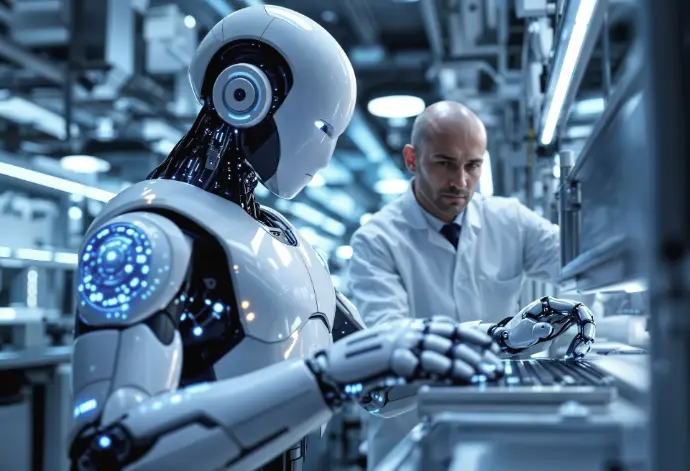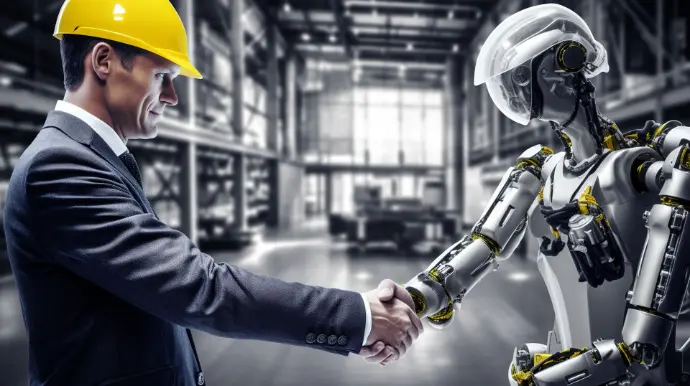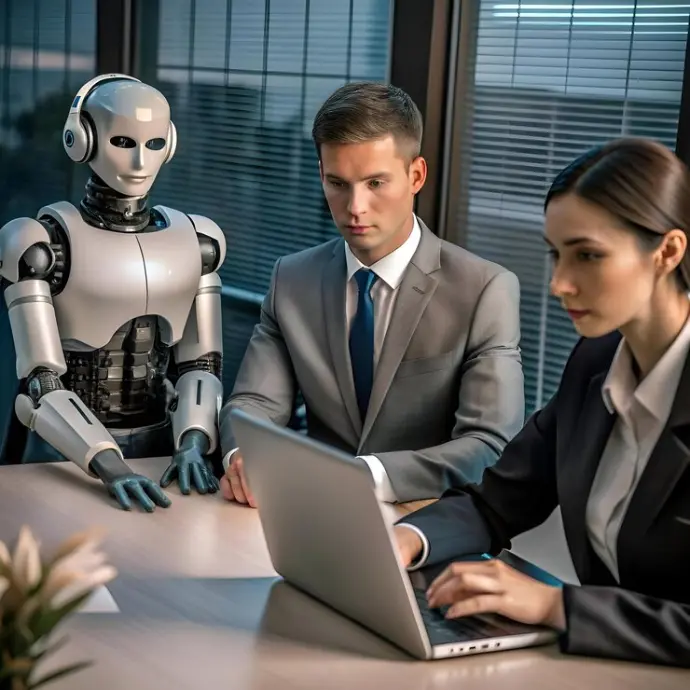Competition or Collaboration: The Influence of Robotics on Human Employment
Here is a captivating tour through the wonders and challenges of emerging technologies. In our feature article, "Competition or Collaboration: The Influence of Robotics on Human Employment," we will analyze how robotics is reshaping the workplace. Get ready to reveal how robotics affects employment and possible responses to this challenge.
Introduction
In recent decades, robotics has achieved remarkably positive developments, transitioning from a field of study to a common reality across multiple sectors. Robots have evolved from basic programmable machines to autonomous systems capable of performing complex tasks with minimal human intervention. This progress has been facilitated by advances in artificial intelligence, computer vision, sensors, and actuators, which have enabled robots to adapt to changing environments and cooperate effectively with humans.
Today, robots are not only used in factories, but have also been incorporated into areas such as healthcare, agriculture, logistics, and entertainment. This constant growth in the capabilities and adaptability of robots has had a significant impact on the labor market and the way humans interact with technology.
Advances in the field of robotics have generated both expectations and concerns, as they raise significant questions about the future of employment, the skills required, and the nature of human-robot interaction in various work environments.
The impact of robotics on the workplace is a topic of constant discussion. Although the introduction of robots has facilitated the automation of repetitive and dangerous tasks, which has increased both safety and efficiency in various industries, it has also raised concerns about job losses. According to a report prepared by the Organization for Economic Cooperation and Development (OECD), it is estimated that approximately 14% of jobs in member countries face a significant risk of automation.
Furthermore, the adoption of robots has led to the emergence of new jobs and employment opportunities, especially in the areas of design, maintenance, and supervision of robotic systems. Furthermore, advances in the field of robotics have facilitated cooperation between humans and machines in the workplace, expanding employee capabilities and giving rise to new business models.
It's important to note that while automation can transform certain job functions, it also has the potential to free workers from monotonous activities, allowing them to focus on tasks that require creativity, strategy, or interpersonal skills. This change could, in turn, foster innovation and economic growth.
Human-robot interaction plays a crucial role in the impact of robotics on employment. As robots are integrated into work environments, it is critical to consider how humans and robots can collaborate effectively. Human-robot interaction is not limited to coexistence in the same space but also encompasses collaboration on tasks, communication, and mutual understanding.
The ability of robots to understand and adapt to human needs and preferences, as well as their ability to work as a team with humans, are fundamental aspects of human-robot interaction. This interaction not only affects efficiency and productivity in work environments but also influences the acceptance and perception of robotics by the workforce and society at large.
Furthermore, human-robot interaction raises ethical and legal challenges, such as privacy, safety, and liability in environments where humans and robots collaborate closely. Understanding these aspects is essential to ensuring a harmonious and beneficial integration of robotics into the work and social environment.

Impact of Robotics on Human Employment
The arrival of robotics and automation has profoundly transformed the labor landscape in recent decades, prompting essential reflections on its impact on human employment. While some perceive it as a clear threat, others see it as an opportunity to move toward a more efficient and specialized labor market. One of the most obvious effects of robotics is the replacement of repetitive and manual tasks. Many industries, especially those related to manufacturing, logistics, and mass production, have adopted robots to optimize their operations. While this has reduced demand for certain traditional jobs, it has also opened the door to new opportunities that require more technical and specific skills, such as programming, robot maintenance, and automated systems management. However, the impact is not uniform. Sectors that are not easily mechanized, such as personal care or the creative arts, continue to rely heavily on human talent. But even in these areas, robotics has complemented certain tasks, improving productivity without replacing workers. One positive aspect of this change is the possibility of reducing occupational risks by delegating dangerous or physically demanding tasks to robots. On the other hand, critics of this transformation argue that it can increase inequality, especially among those without access to advanced technological training. To address this challenge, solutions continue to focus on education and training. Adapting to an automated world not only involves learning to work alongside machines, but also developing irreplaceable human skills, such as creativity, critical thinking, and empathy. Ultimately, although robotics is revolutionizing human employment at an accelerated pace, its impact does not have to be negative. With appropriate policies and a proactive approach to job preparation, the benefits can outweigh the adversities, building a balance between technological innovation and social development. This is a historic moment that invites us to reimagine our relationship with work and the role of machines in our daily lives.

The automation of activities, fueled by advances in robotics and artificial intelligence, has significantly revolutionized the way various work tasks are performed. Routine and repetitive activities, previously performed by human workers, are now performed by robots and autonomous systems. This has led to greater production efficiency and reduced costs for companies, although it has also raised questions about the impact on human employment.
Although automation has eliminated certain job roles, it has also generated new positions in areas such as the development, maintenance, and supervision of robotic systems. Additionally, it has allowed human workers to focus on more complex and creative activities, which can lead to higher job satisfaction and increased productivity. However, it is vital to address the relocation and training of employees affected by automation to minimize potential adverse effects on employment.
The interaction between automation and human employment is intricate and multifaceted, requiring a balanced approach that promotes cooperation between humans and robots in the workplace.
Robotics has brought about significant change in the industrial sector, facilitating the creation of safer, more efficient, and more flexible workplaces. Robots in the industrial field have demonstrated their ability to perform activities that involve risks or are repetitive, thereby reducing the risk of workplace accidents and improving the working conditions of human workers.
Furthermore, the inclusion of collaborative robots, which can interact safely with human personnel, has led to greater adaptability within the production chain. This has allowed organizations to adjust more quickly to variations in market demand, improve product quality, and refine manufacturing procedures.
Despite the clear advantages that industrial innovation enabled by robotics offers, concerns have also arisen regarding the potential replacement of conventional jobs with automated systems. It is essential to strike a balance between the application of robotic technologies and the preservation of substantial job opportunities for human workers.
The integration of emerging technologies, including robotics, has had a notable impact on the structure and dynamics of employment in different sectors. The demand for skills related to the programming, design, and operation of robotic systems has increased considerably, generating new job opportunities for professionals with technological specialization.
On the other hand, the incorporation of robots and autonomous systems has presented challenges in terms of retraining and redeployment for employees whose jobs have been automated. It is vital to create workforce transition strategies that facilitate the adaptation of the workforce to changing market demands, thus ensuring a fair and sustainable shift toward a progressively automated work environment.
The adoption of emerging technologies, such as robotics, has transformed the employment landscape, offering both opportunities and challenges to the human workforce. The influence of robotics on employment continues to be a topic of discussion and reflection, demanding a comprehensive and collaborative approach to ensure a fair and prosperous future of work.
The growing presence of robotics and artificial intelligence in the workplace presents various challenges and opportunities for workers. On the one hand, the automation of repetitive and dangerous tasks can free employees from routine activities, allowing them to focus on more creative and strategic work. This can result in increased job satisfaction and performance quality, as well as opening up new avenues for professional development in technology-related fields.
On the other hand, the arrival of robots and autonomous systems also creates considerable challenges for many employees, particularly those whose roles are easily replaced by automation. In areas such as manufacturing, logistics, and customer service, the adoption of robotic technology could result in the decline of conventional jobs, requiring a review of the skills needed to maintain employability in a constantly changing work environment.
It is essential that both governments and private organizations identify these challenges and collaborate to develop policies and training programs that prepare workers for the changing demands of the labor market. Teaching digital skills, providing professional retraining, and promoting continuing education are essential components for minimizing the adverse effects of automation and taking advantage of the opportunities arising from the integration of robotics into the workplace.

Collaboration between humans and robots
The union between humans and robots has established itself as a crucial issue in the workplace, marking a transformation in the way we understand the interaction between technology and human labor. Collaborative work environments have emerged as an alternative to the traditional perception of competition between people and machines, promoting the notion that their cooperation can generate key synergies to improve productivity and quality in various industries. This type of collaboration is reflected in the incorporation of robots to perform specific tasks that complement human skills. In this way, repetitive or risky processes are automated, allowing workers to focus their efforts on activities that require creativity, decision-making, or emotional skills. The introduction of robots in these collaborative environments represents a new model that seeks to combine the strengths of both: the precision, speed, and resilience inherent to machines with the flexibility, adaptability, and learning capacity inherent to humans.
Cooperation between humans and robots offers a variety of significant advantages for employees and organizations. First, the automation of repetitive and dangerous activities through collaboration with robots reduces the risk of workplace incidents, as well as the physical and mental fatigue of workers, which in turn promotes improved occupational health and safety.
Furthermore, the inclusion of robots in collaborative workspaces can increase both the efficiency and quality of production, allowing employees to focus their attention on functions that require exceptional human skills, such as problem-solving, social interaction, and creativity. Similarly, collaboration with robots can create new employment opportunities in fields related to the design, operation, and supervision of robotic systems, thus fostering the development of specialized skills.
Human-robot interaction in the workplace not only has the potential to increase productivity and quality, but also to improve employee well-being while stimulating the development of new job competencies.
The inclusion of robots in collaborative work environments not only affects the distribution of activities but also the fostering of new work skills. As routine tasks are delegated to robots, workers have the opportunity to develop more specialized and adaptive skills that allow them to interact with technology efficiently.
The improvement of skills such as programming, monitoring robotic systems, analyzing data generated by robots, and solving complex problems becomes essential in collaborative workspaces. Similarly, the ability to collaborate with robots, understand their functioning, and optimize their performance becomes a key competency in the future labor market.
In this context, cooperation between humans and robots not only transforms the essence of work but also highlights the need for continuous training and skills renewal to adapt to the changing demands of the work environment.

Competition between humans and robots
The confrontation between humans and robots has gained prominence in various fields, generating debates and reflections on the capabilities, limitations, and roles of each. As automation and artificial intelligence continue to advance, questions arise about their impact on employment, productivity, and human creativity.
Far from being a simple rivalry, this interaction can be interpreted as an opportunity to complement each other. Robots excel at repetitive tasks or those requiring high levels of precision, while humans contribute creative, emotional, and ethical skills that machines lack. The main challenge lies in finding a balance where technology does not replace people, but rather empowers them in their responsibilities.
Therefore, the real objective should not focus on direct competition, but on how both parties can work together to create an inclusive, efficient, and humane future.
The incorporation of robotics in industries such as manufacturing, logistics, and customer service has had a considerable impact on the execution of everyday activities. In manufacturing, robots have proven effective in performing repetitive and risky tasks, resulting in increases in both productivity and product quality. In the logistics sector, autonomous robots are being used to manage warehouses, speeding up storage and distribution procedures. In customer service, chatbots and virtual assistants are taking over customer service and technical support functions, allowing human employees to focus on more complex and meaningful interactions.
In medicine, surgical robotic systems have enabled more precise and less invasive interventions, thus improving patient outcomes. In the agricultural sector, drones and agricultural robots are being used to monitor and optimize food production. These technological advances are revolutionizing the way different tasks are performed in specific sectors, generating efficiency and quality improvements, although they also present challenges related to workforce adaptation and retraining.
Ethical and Social Challenges
The integration of robotics in the workplace presents significant ethical dilemmas, given that the automation of various functions could compromise individual job security. It is essential to assess how the change process will be carried out for employees whose jobs will be altered by the arrival of robotics in the workplace. It is essential to develop strategies that ensure the safeguarding of labor rights, as well as to encourage relocation or training for those at risk of losing their jobs. It is also crucial to ensure that workplace robotics operates according to rigorous ethical principles, avoiding situations in which humans are indiscriminately replaced by machines, without regard for their well-being or future employment.
The ethics related to the implementation of workplace robotics also include the obligations of robot creators and manufacturers. It is essential that technological development not only seek to optimize efficiency and production, but also consider the social and human impact of this technology. Artificial intelligence and robotics systems must be conceived from an ethical perspective, considering their impact on human employment, fairness at work, and the dignity of employees.
In this context, cooperation between ethicists, legislators, employers, and workers is key to establishing clear standards that guide the responsible adoption of robotics in society, ensuring that the benefits are maximized and the negative impacts minimized.
The incorporation of robotics into the professional environment can significantly transform workers' quality of life. When carried out responsibly, robotics has the potential to free employees from monotonous, dangerous, or physically strenuous tasks, allowing them to focus on activities that demand specific human skills, creativity, and decision-making abilities. By freeing workers from these burdens, robotic technology can facilitate a reduction in work-related stress and improve employees' emotional well-being.
Furthermore, robotics in the workplace can generate new job opportunities in sectors related to the design, maintenance, and supervision of automated systems, creating new employment prospects and fostering the development of specialized skills within the workforce.
However, it is essential to address potential adverse effects on employees' quality of life, such as the stress and anxiety that can arise from job instability. The adoption of robotics must be complemented by support and training programs for affected workers, ensuring that the transition to a more automated work environment is carried out in a fair and equitable manner, in addition to promoting continuous improvement in employees' quality of life.
The incorporation of robotics into the workplace presents significant challenges related to labor justice. There is a risk that automation will increase the disparity between employees with high levels of qualifications and those with more basic skills, intensifying inequality in the labor market. It is imperative to address these inequalities through the implementation of policies that promote equal opportunities and equitable access to technological skills training.
Furthermore, labor justice is also linked to the equitable distribution of the economic benefits generated by robotics. It is essential to ensure that the productivity increases resulting from automation are reflected in better wages and working conditions for all workers, rather than being concentrated solely in a small group of highly skilled employees or company owners.
In this regard, labor justice should be a central component in discussions and decisions related to the integration of robotics, ensuring that the technology is used to foster a more equitable and sustainable work environment for all members of the workforce.
Conclusions
The development of robotics and artificial intelligence is shaping a landscape in which human-machine interaction will become increasingly common. It is anticipated that, in the future, robots will not only perform routine tasks but will also be able to cooperate safely and effectively with humans in settings such as factories, hospitals, warehouses, and homes.
This type of collaboration presents both challenges and opportunities. On the one hand, the automation of certain functions is expected to allow humans to focus on more creative, strategic, and value-added activities. On the other hand, it is essential to ensure that human-robot interaction is safe, ethical, and respectful, avoiding worker exclusion and encouraging training and adaptation to new work dynamics.
Additionally, interface design, along with human-robot communication, will be key elements in ensuring effective interaction. Advances in this sector will not only affect the workplace but also the daily lives of individuals, changing the way we interact with technology.
The impact of robotics on employment is a complex issue encompassing economic, social, and ethical dimensions. Although automation may displace certain job positions, it is equally vital to recognize that the arrival of innovative technologies fosters the creation of new positions and the need for specific skills.
In this context, it is essential to promote training in disciplines related to robotics, programming, cybersecurity, and information management, among others. Adapting to new work dynamics and continuously updating knowledge will be crucial to facing the challenges and taking advantage of the possibilities offered by robotics and automation.
Likewise, it is imperative to promote dialogue among various stakeholders, including governments, businesses, workers, and society as a whole, to establish policies and strategies that ensure an equitable transition to a future in which collaboration between humans and robots benefits all involved.

 IHRO NEWS
IHRO NEWS